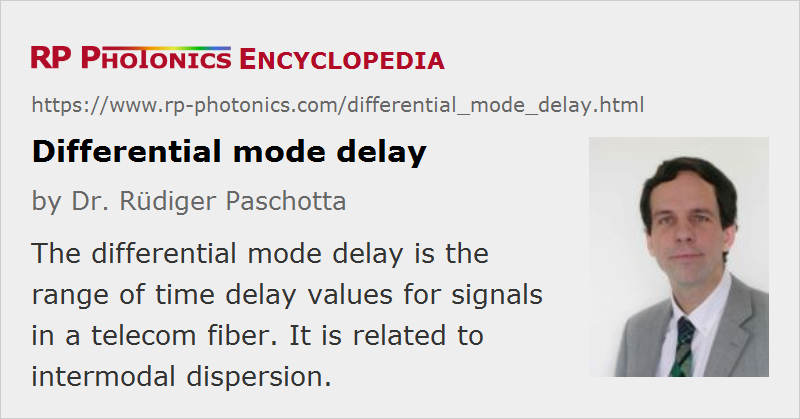Differential Mode Delay
Acronym: DMD
Definition: the range of time delay values for signals in a telecom fiber
Categories: fiber optics and waveguides, lightwave communications, light pulses
How to cite the article; suggest additional literature
Author: Dr. Rüdiger Paschotta
The group velocities of different modes in a multimode fiber are generally different, resulting in mode-dependent group delays for a given length of fiber. This phenomenon of intermodal dispersion is generally a limiting factor for the achievable transmission bandwidth (data rate) in optical fiber communications as far as multimode fibers are used.
For quantifying intermodal dispersion in telecom fibers, one usually specifies the differential mode delay (sometimes also called differential modal delay or differential group delay). This is often essentially understood as the difference between the maximum and minimum time delay (group delay) of a short signal pulse within a certain length of the fiber under test. It must be measured under carefully standardized conditions, e.g. using bandwidth-limited ultrashort pulses with a certain pulse duration well below the DMD result. The pulses should be in a diffraction-limited beam at a certain optical center wavelength, and the time delay should be measured for a range of radial positions of the input beam across the fiber core. Special DMD analyzer tools have been developed for such measurements.
In some cases, the difference in mode delays between two particular modes is considered. In such cases, positive and negative results are possible; indeed, one can design fibers where e.g. the LP11 mode is a higher or lower group velocity than the LP01 mode, or that difference may even change sign due to uncontrolled variations of fiber parameters in the fiber fabrication.
For constant fiber properties along the whole length, the total difference in group delays is proportional to the fiber length. Therefore, the differential mode delay is often specified in picoseconds per kilometer (ps/km), for example. Its value can substantially depend on the optical wavelength.
Graded-index fibers can be optimized for a small differential mode delay, which however is usually achieved only within a quite limited wavelength range. This limits the application of wavelength division multiplexing. There are special wideband multimode fibers, however, where a low differential mode delay is achieved over a larger wavelength range with the width of e.g. 100 nm.
Typical differential group delays of few-mode fibers with step-index profile are of the order of several picoseconds per meter (ps/m), while graded-index fibers can be made with differential group delays far below 1 ps/m, in some cases even well below 0.1 ps/m = 100 ps/km.
A minimized differential mode delay is not ideal for all applications. For example, intermodal nonlinear effects such as cross-phase modulation can be more strongly disturbing in fiber-optic telecom systems based on fibers with low differential mode delay. In some cases, one uses sequences of fibers having opposite signs of differential mode delay, so that the local DMD is relatively large, and nevertheless the total difference in group delay is over long transmission line are relatively small.
Questions and Comments from Users
Here you can submit questions and comments. As far as they get accepted by the author, they will appear above this paragraph together with the author’s answer. The author will decide on acceptance based on certain criteria. Essentially, the issue must be of sufficiently broad interest.
Please do not enter personal data here; we would otherwise delete it soon. (See also our privacy declaration.) If you wish to receive personal feedback or consultancy from the author, please contact him e.g. via e-mail.
By submitting the information, you give your consent to the potential publication of your inputs on our website according to our rules. (If you later retract your consent, we will delete those inputs.) As your inputs are first reviewed by the author, they may be published with some delay.
See also: intermodal dispersion, group velocity, group delay, multimode fibers, few-mode fibers, telecom fibers, graded-index fibers
and other articles in the categories fiber optics and waveguides, lightwave communications, light pulses
 |




If you like this page, please share the link with your friends and colleagues, e.g. via social media:
These sharing buttons are implemented in a privacy-friendly way!